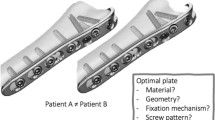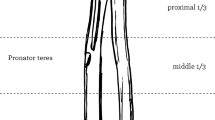Abstract
Purpose
Traditional classification systems for tibial plateau fractures (TPF) are based on simple radiographs, and intra- and inter-observer variability is low. The aim was to assess intra- and inter-observer variability using traditional systems and some recently described classification systems of TPF in the interpretation of standard radiographs and bidimensional (2D) and tridimensional (3D) computed tomography (CT).
Methods
We studied all patients at two centres who underwent TPF surgery over a three-year period. Demographic data (age, sex, BMI) and mechanism of injury were recorded. Four observers classified each TPF according to the Schatzker, AO, Luo, modified Duparc and Khan classification systems. We calculated intra- and inter-observer variability using the Kappa test.
Results
A total of 112 (71 males) patients were included. Mean age was 47.1 years (range 21–86) and mean BMI was 25.2 ± 3.6. Intra- and inter-observer variability was 0.95 and 0.62 for AO, 0.87 and 0.65 for Schaztker, 0.86 and 0.73 for Luo, 0.56 and 0.37 for the modified Duparc, and 0.43 and 0.25 for Khan classifications.
Conclusions
Although previous training could be needed, AO, Schatzker and Luo classifications showed a good reproducibility of TPF assessment from a combination of standard radiographs and 2D and 3D CT images. The results using the Modified Duparc and Khan classifications were less favourable and their use is not therefore recommended.





Similar content being viewed by others
References
Agnew SG (1999) Tibial plateau fractures. Oper Tech Orthoped 9:197–205
Zhu Y, Yang G, Luo CF, Smith WR, Hu CF, Gao H, Zhong B, Zeng BF (2012) Computed tomography-based three column classification in tibial plateau fractures: Introduction of its utility and assessment of its reproducibility. J Trauma and Acute Care Surg 73:731–737
Schatzker J, McBroom R, Bruce D (1979) The tibial plateau fracture. The Toronto experience 1968—1975. Clin Orthop Relat Res 138:94–104
Honkonen SE, Järvinen MJ (1992) Classification of fractures of the tibial condyles. Bone Joint Surg Br 74:840–847
Muller ME, Allgower M, Schneider R, Willenegger H (1992) Manual der Osteosynthese. Springer, New York-Berlin-Heidelberg
Hohl M (1967) Tibial condylar fractures. J Bone Joint Surg Am 49:1455–1467
Moore TM (1981) Fracture-dislocation of the knee. Clin Orthop Relat Res 156:128–140
Wahlquist M, Iaguilli N, Ebraheim N, Levine J (2007) Medial tibial plateau fractures: a new classification system. J Trauma 63:1418–1421
Khan RMS, Khan SH, Ahmad AJ, Muhammad U (2000) Tibial plateau fractures: a new classification scheme. Clin Orthop Relat Res 375:231–242
Marsh JL, Slongo TF, Agel J, Broderick JS, Creevey W, DeCoster TA et al (2007) Fracture and dislocation classification compendium - 2007: Orthopaedic Trauma Association classification, database and outcomes committee. J Orthop Trauma 21:S1–33
Macarini L, Murrone M, Marini S, Calbi R, Solarino M, Moretti B (2004) Tibial plateau fractures: evaluation with multidetector-CT. Radiol Med 108:503–514
Doornberg JN, Rademakers MV, van den Bekerom MP, Kerkhoffs GM, Ahn J, Steller EP et al (2011) Two-dimensional and three-dimensional computed tomography for the classification and characterisation of tibial plateau fractures. Injury 42:1416–1425
Charalambous CP, Tryfonidis M, Alvi F, Moran M, Fang C, Samarji R et al (2007) Inter and intra-observer variation of the Schatzker and AO/OTA classifications of tibial plateau fractures and a proposal of a new classification system. Ann R Coll Surg Engl 89:400–404
Hu YL, Ye FG, Ji AY, Qiao GX, Liu HF (2009) Three-dimensional computed tomography imaging increases the reliability of classification systems for tibial plateau fractures. Injury 40:1282–1285
Muller ME, Nazarian S, Koch P (1987) Classification AO des fractures. Springer, Berlin
Gicquel T, Najihi N, Vendeuvre T, Teyssedou S, Gayet LE, Huten D (2013) Tibial plateau fractures: Reproducibility of three classifications (Schatzker, AO, Duparc) and a revised Duparc classification. Orthop Traumatol Surg Res 99:805–881
Cohen J (1960) A coefficient of agreement for nominal scales. Educ Psycho Meas 20:37–46
Petrie A (2006) Statistics in orthopaedic papers. J Bone Joint Surg (Br) 88:1121–1136
Landis JR, Koch GG (1977) The measurement of observer agreement for categorical data. Biometrics 33:159–174
Mellema JJ, Doornberg JN, Molenaars RJ, Ring D, Kloen P, Babis GC et al (2016) Interobserver reliability of the Schatzker and Luo classification systems for tibial plateau fractures. Injury 47:944–949
Audigé L, Bhandari M, Kellam J (2004) How reliable are reliability studies of fracture classifications? A systematic review of their methodologies. Acta Orthop Scand 75:184–194
Te Stroet MAJ, Holla M, Biert J, Van Kampen A (2011) The value of a CT scan compared to plain radiographs for the classification and treatment plan in tibial plateau fractures. Emerg Radiol 18:279–283
Dias JJ, Stirling AJ, Finlay DB, Gregg PJ (1987) Computerised axial tomography for tibial plateau fractures. J Bone Joint Surg (Br) 69:84–88
Markhardt BK, Gross JM, Monu J (2009) Schatzker classification of tibial plateau fractures: Use of CT and MR imaging improves assessment. Radiographics 29:585–597
Wicky S, Blaser PF, Blanc CH, Leyvraz PF, Schnyder P, Meuli RA (2000) Comparison between standard radiography and spiral CT with 3D reconstruction in the evaluation, classification and management of tibial plateau fractures. Eur Radiol 10:1227–1232
Yang G, Zhu Y, Luo C, Putnis S (2012) Morphological characteristics of Schatzker type IV tibial plateau fractures: a computer tomography based study. Int Orthop 36:2355–2360
Brunner A, Horisberger M, Ulmar B, Hoffmann A, Babst R (2010) Classification systems for tibial plateau fractures; does computed tomography scanning improve their reliability? Injury 41:173–178
Carrera I, Gelber PE, Chary G, González-Ballester MA, Monllau JC, Noailly J (2016) Fixation of a split fracture of the lateral tibial plateau with a locking screw plate instead of cannulated screws would allow early weight bearing: a computational exploration. Int Orthop 40:2163–2169
Chang SM, Hu SJ, Zhang YQ, Yao MW, Ma Z, Wang X, Dargel J, Eysel P (2014) A surgical protocol for bicondylar four-quadrant tibial plateau fractures. Int Orthop 38:2559–2564
Ehlinger M, Adamczewski B, Rahmé M, Adam P, Bonnomet F (2015) Comparison of the pre-shaped anatomical locking plate of 3.5 mm versus 4.5 mm for the treatment of tibial plateau fractures. Int Orthop 39:2465–2471
Weil YA, Gardner MJ, Boraiah S, Helfet DL, Lorich DG (2008) Posteromedial supine approach for reduction and fixation of medial and bicondylar tibial plateau fractures. J Orthop Trauma 22:357–362
Higgins TF, Kemper D, Klatt J (2009) Incidence and morphology of the posteromedial fragment in bicondylar tibial plateau fractures. J Orthop Trauma 23:45–51
Zeng ZM, Luo CF, Putnis S, Zeng BF (2011) Biomechanical analysis of posteromedial tibial plateau split fracture fixation. Knee 18:51–54
Acknowledgements
We are grateful to Iganaci Gich for assisting in the statistical analysis.
This study was awarded Best Podium Presentation at the 53th meeting of the Spanish Society of Orthopaedics Surgery and Traumatology (SECOT) in September 2016.
Author information
Authors and Affiliations
Corresponding author
Ethics declarations
Conflict of interest
On behalf of all authors, the corresponding author states that there are no competing interests.
Rights and permissions
About this article
Cite this article
Millán-Billi, A., Gómez-Masdeu, M., Ramírez-Bermejo, E. et al. What is the most reproducible classification system to assess tibial plateau fractures?. International Orthopaedics (SICOT) 41, 1251–1256 (2017). https://doi.org/10.1007/s00264-017-3462-x
Received:
Accepted:
Published:
Issue Date:
DOI: https://doi.org/10.1007/s00264-017-3462-x




